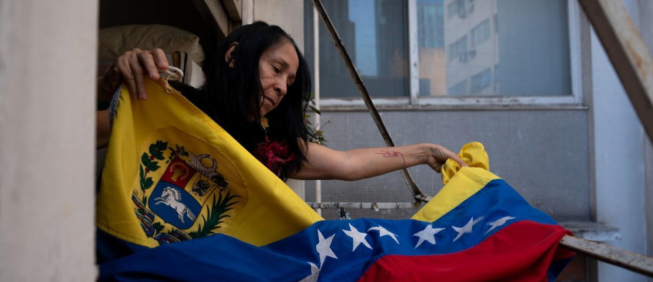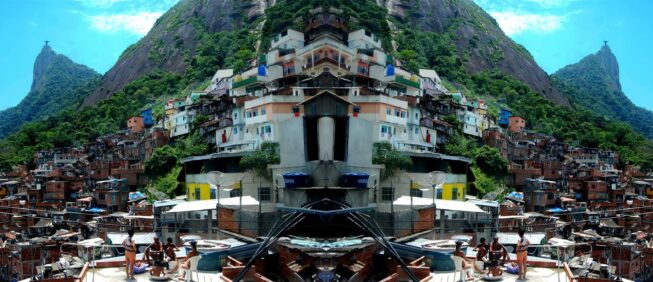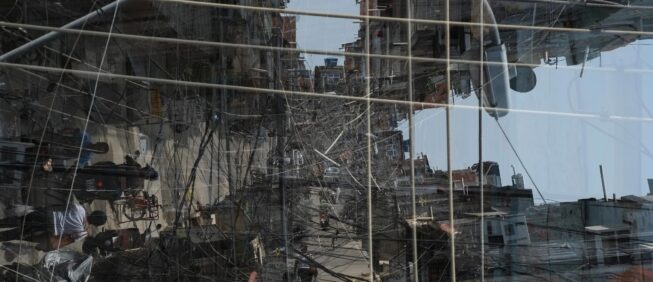Social Struggles and the Role of Conservation Units
Popular resistance in the neighborhood of Vargens de Sernambetiba, Rio de Janeiro
Brasiliano Vito Fico
| Brazil |
18 de August de 2020
translated by Edmund Ruge
Abstract
This article centers on the importance of the emergence of social conflicts in a metropolis-adjacent urban space, the area of Vargens de Sernambetiba. In the periurban landscape of Vargens, social groups continue to struggle for a more democratic and plural city. These actors, in exercising their citizenship, demonstrate the union of platforms in diverse struggles for the environment, for housing, for the right to plant, or simply for the right to maintain a lifestyle that is distinct from that of the urban center.
The article also explains how the State can contribute to a deep improvement in the life conditions of these residents. Finally, I seek to prove that the Conservation Units (UCs) of Rio de Janeiro can be spaces of resistance against the groups that have created an unequal and unsustainable city model.
Vargens as a peripheral space
What Magalhães Corrêa (2017) called the Sertão Carioca (Rio Backlands) — a wild space, inaccessible, and absent of modernities — exists today in Vargens de Sernambetiba, or simply “Vargens,” the combination of the neighborhoods of Vargem Grande and Vargem Pequena. The two Vargens are the last border with the large capitals connected to real-estate speculation in the Baixada de Jacarepaguá area. The speculative assault on this vast region is not restricted to the plains area: it reaches the slopes of the Pedra Branca massif, on the edges of the state park.

In 1969, the architect Lúcio Costa projected a new central nucleus for the city, merging flows of people and capital around the western neighborhood of Barra da Tijuca. The proposed design borrowed modernist urbanistic concepts applied in the plano piloto (pilot plan) urban layout of Brasilia, with the creation of grand avenues and the valorization of car-based locomotion. The Lúcio Costa plan endeavored to protect the landscape and maintain the traditional activities of the old Sertão.
Much of what was proposed in Costa’s plan was lost in later urbanistic legislation. However, the Vargens would remain into the beginning of the 21st century, holding wide agricultural lots under the force of 1981’s Decree 3,0461DECRETO Nº 3.046, DE 27 DE ABRIL DE 1981. Consolidates the normative instructions and other complimentary acts in order to regulate the occupation of land in the area of Special Zone 5 (ZE-5), defined and delineated by Decree 322, of 3/3/1976
It was only with the Urban Structuration Project (Projeto de Estruturação Urbana, PEU) created by Complimentary Law 79/2006 and recreated under Complimentary Law 104/20092 LEI COMPLEMENTAR No. 104, DE 27 DE NOVEMBRO 2009. Institutes the Urban Structuration Project, PEU, of the neighborhoods of Vargem Grande, Vargem Pequena, Camorim, and part of the neighborhoods of Recreio dos Bandeirantes, Barra da Tijuca, and Jacarepaguá, in the 24th and 26th Administrative Regions, member numbers 46, 47, 40, and 45 of the Spatial Planning Units and other items., an initiative of the Rio City Council, that the Vargens areas gained up-to-date legislation. The law became known as “PEU Vargens” and includes the neighborhoods of Camorim and parts of Recreio and Jacarepaguá. It proposed massive urban uses in the area formed around the areas of Canais de Sernambetiba, Portelo, and Cortado, in flood-prone areas of those wide plains. It also incentivized the occupation of the outer limits of Pedra Branca park (Figure 2)..

The intensification of urban use and the expansion forecast in the plan is gigantic, as seen in Table 1. The region, which today is home to around 170 thousand inhabitants, could be occupied by nearly 3 million if the plan is implemented, representing a 300% increase in population density in relation to previous legislation.


The red and orange areas highlighted in Figure 9 demonstration the areas of High and Very High susceptibility to flooding in the physical environment. The occupation of these areas is only possible when large interventions throughout the landscape allow for the reduction of risks to new residents, especially in the low, flood-prone areas there, the installation of expensive infrastructure for draining and grounding will demand a financial return compatible with high investment from the civil construction market. This process will make it impossible to keep the area liveable for low-income residents, inevitably leading to gentrification in Vargens (Name, et al, 2011).

Social groups’ identification with the territory - mobilization and resistance
The Sertão’s remaining groups have transmuted. Some have kept their ties to their struggle for ancestral lands: the Quilombos. Others have committed themselves to the struggle for housing and against evictions. There are also those that practice agricultural activities near their living space, maintaining a simple and quiet lifestyle.
According to the Brazilian Institute for Geography and Statistics’ (IBGE) 2017 Agricultural Census, Vargens contains 87 productive establishments, mostly occupying the low slope areas. This fact confirms the permanence of ancestral planting traditions.

The women’s affirmation movement in this territory gained space and demands the maintenance of the traditions of planting and living.
Around the grouping of mountains of Pedra Branca, there also live women that live and plant in the West Zone. In the past, they were far fewer in number (...) But the quintais do not keep silent.
The plantations atop the massif are extensive. They exist on inclined terrain and mix with the forest. On the other hand, the wetland plantations are made on flat earth and inside the matriarchal gardens. However, just as much atop the mountains as in the valleys and plains, mixed agriculture prevails. [bolding ours]3 Instituto PACS; Comitê Popular de Mulheres da Zona Oeste & Rede Carioca de Agricultura Urbana. Morar e Plantar. 2018. Available at http://biblioteca.pacs.org.br/wp-content/uploads/2018/04/morar-e-plantar-atualizado.pdf
With the new legislation and the real-estate boom triggered by the large sporting events of 2010, social groups mobilized for resistance to keep their ways of life and for improvements in the conditions of their permanence. They worried over the loss of identity, over the destruction of the natural environment, and sought to strengthen popular participation in the face of speculation. The warlike removal of the residents of the community of Vila Autódromo in 2016 was an alert signal and an inspiration for the need to strengthen the organization of social actors in Vargens4ASSOCIAÇÃO DE MORADORES E PESCADORES DA VILA AUTÓDROMO (AMPVA). Plano Popular da Vila Autódromo. 2013. Available at (https://vivaavilaautodromo.files.wordpress.com/2016/02/ppva_2016web.pdf) .
Notable actors in this mobilization for the rights of Vargens residents include:
- Quilombo Cafundá Astrogilda - occupied by the remaining slaves from the old coffee plantations of Pedra Branca. The residents maintain their traditional practices, many of them still planting in the forest, though this production faces difficulties. Threatened with eviction from Pedra Branca park, the residents fought to obtain their official recognition with the help of the Palmares Foundation, succeeding in 2014.
- The Rio Network of Urban Agriculture (Rede CAU) - connected to the Rio de Janeiro Agroecology Group (AARJ), the National Collective for Urban Agriculture, and the National Agroecology Group (ANA)
- The Residents and Friends of Vargem Grande Association (AMAVAG)
- The Women’s Popular Collective of the West Zone - organizes women and the distinct local organizations of the city of Rio de Janeiro around a movement for a more egalitarian, anti-racist, anti-patriarcal society without homophobia.
The Vargens Popular Plan
The Plan, launched in October of 2017, was created by the Vargens Popular Plan Group, uniting countless local actors in partnership with university researchers5 ARTICULAÇÃO PLANO POPULAR DAS VARGENS – APP. Plano Popular das Vargens. 2017. http://sertaocarioca.org.br/2018/01/plano-popular-das-vargens-versao-completa/. The plan is a response to the threats originated in the PEU that allow for profound modifications in the local environment and would strip residents of their right to the city.
The document proposes to protect traditional populations, their territory, their way of life, and their agroecological practices. The diverse organized groups and the university dialogue in the document’s development, making it even stronger.
It is revealing to note that the Plan cites women as the foundation of popular organization and of work. It goes further, declaring that, behind the new law, there is an attempt to eliminate the presence of Black people in the increasingly capital-valued space.
The urbanistic projects that they are attempting to impose on our region should also be recognized as part of a racist policy, which acts in the sense of promoting the whitening of the region rather than recognizing its residents, their origins and ancestrality, their cultural identity (p. 37)

The Plan sought to reinforce popular autonomy and women’s organizing; strengthen Black identities and Black permanence in their territories; guarantee the right to information and of representation by the local population in spaces of political decision-making; articulate and strengthen the organizations that act in Vargens.
The curious contradiction in the intense fight for territory in Vargens undertaken by its residents is that it reveals a social dynamism rarely seen in other regions of the city, the struggle for permanence, for tradition, taken up by people often called “backward.” Now, in this city, historically marked by the absence of planning and misdirection of policies of occupation of territories in the direction of the most privileged, is this struggle for this peripheral space not a uniquely democratic and modern aspect?6For more on this, see SANTOS, Milton. Por uma outra Globalização: do pensamento único à consciência universal. 2000
Green Grabbing and the participation of the State in the promotion of the environment
Capturing nature as an asset for real-estate capital in the creation of new urban nuclei in the Baixada de Jacarepaguá area is a recurring phenomenon. The imaginary of a natural paradise, with lakes, forests, and beaches, began to be intensely exploited beginning in the 1960s, coinciding with an incentive for the middle class population to move from the city’s South Zone.

The last sector to be incorporated in the speculation process was limited to the West, in the Vargens area, which show, to this day, characteristics of periurban occupation. This population is wedged between the flooded swamps, which belong to a handful of owens, and the forests of Pedra Branca.
After 1974, with the creation of Pedra Branca park, traditional residents, busy with life and planting, found themselves at the center of a conflict with the state government. Afterall, the park would not permit the permanence of traditional communities, some of whom had resided there in the protected area for more than 100 years.
Penna-Firme (2015) shows how “green capitalism” incorporates the environment and the UC as part of a mercantilist strategy involving nature and the accumulation of capital. A value of exchange is attributed to nature and the UCs can generate profit and indirect benefits to those that control them. This “green” appropriation of territories by capital is called green-grabbing. Despite the ecological importance of the conservation of resources, the creation of the UC as well as the PEPB has created conflict and social injustice.
It is as if the UCs, as instruments of capital, represented an obstacle to the maintenance of tradition.
As Benatti (2008) has warned, the creation of the UCs cannot be limited to technical and scientific aspects. It should include social processes in the territory. The environment should be seen in a unifying way, including historical and cultural dimensions.
In 2013, following widely-noted flooding in the regions of Vargens and Guaratiba, including the destruction of the Pntal Museum and of the Campus Fidei (site where the PAPA MISSA CAMPAL was held), the City temporarily extinguished the effects of Complementary Law 104/2009 with the institution of the two Areas of Special Environmental Interest (AEIA) in Vargens and Guaratiba. The AEIA are instruments created in the City’s Directive Plan and hold temporary character. The City suspended all authorizations of new businesses for 180 days; the validity of the AEIA was renewed, successively, for nearly five years, until the return of PEU status in 2019.
The City, the, in 2018, through the Secretariat for the Environment, inspired in the Vargens Popular Plan and in the demands of social groups in the region, developed a proposal to substitute the PEU for two UCs that would protect the natural floodable environment, the slopes alongside Pedra Branca pak, maintain traditional activities, and reduce the rates of occupation predicted in the PEU. The proposal was presented to the public and sits in the City’s technical offices, awaiting approval7 The Technical Study and the proposal of the creation of the UC awaits hearing from municipal authorities for the beginning of a Public Consultation, a stage outlined by the National System of Conservation Units.
The Vargens are surrounded by several UCs. This begs the question of how an area of recognized environmental fragility and of high ecosystem value has never been the object of a creation of a protective legal instrument (Figure 7).

The technical study, fundamental to the creation of any UC8The technical study, fundamental to the creation of any UC sought to create comprehensive protection for the center of the floodable Vargens area, and to provide for sustainable use, in the surrounding areas where there exists interest to maintain low-density urban occupation or agricultural activity. The new units would be limited, broadly, to the neighborhoods of Vargem Pequena and Vargem Grande, limited by the PEPB and Recreio dos Bandeirantes, including areas close to Avenida Salvador Allende. sought to create comprehensive protection for the center of the floodable Vargens area, and to provide for sustainable use, in the surrounding areas where there exists interest to maintain low-density urban occupation or agricultural activity. The new units would be limited, broadly, to the neighborhoods of Vargem Pequena and Vargem Grande, limited by the PEPB and Recreio dos Bandeirantes, including areas close to Avenida Salvador Allende.9The Environmental Secretariat officially presented a proposal for the creation of the UCs in three separate occasions: at the Ordinary Meeting of the Subcommittee for the Lake System of Barra and Jacarepaguá, on 4/12/2019; at the “Disorderly growth in Vargens: Impacts, Challenges, and Solutions,” seminar, held by the Environmental Law Commission and the Barra da Tijuca Bar Association on 11/30/2019; and at the State Legislative Assembly’s Public Hearing for the Defense of the Environment to discuss socio-environmental issues in the Baixada de Jacarepaguá area on 12/6/2019.
In Vargens, any environmental manager faces an enormous challenge: that of recognizing the legitimacy of the speech, representation, and demands of the myriad social groups present. In this new incarnation of the Sertão Carioca, feminism, agriculture, environment, housing, and ancestrality mix and converge to find understanding.
However, dialogue between the region’s social movements and public authorities is minimal, which is completely understandable. The format for social participation obscures the understanding of excessively technical issues. Furthermore, urbanistic legislation that has ignored traditional communities has made this relationship even more difficult for public agents.
The institution of the UCs could, contrary to the developments of the recent past, be the best instrument for the construction of a fruitful dialogue, as it allows for the convergence of the goals of the State with the interests of society in at least four points.
- Environmental conservation
- The maintenance of modes of traditional life
- The inclusion of marginalized groups
- The development of agroecological activity
The UCs are managed by two fundamental instruments, the Management Plan (Plano de Manejo) and the Unit Council (Conselho da Unidade). The interests manifested in the sound management of the Unit must be beneficial to the large majority of residents. As stated by the Vargens Popular Plano, it is necessary to create spaces for effective organizing and popular participation, with autonomy and decision-making power.
Again: the UC management must be democratic, inclusive, and participative. The State, when it exercises its legal prerogative to create the UCs, must provide the institutional conditions necessary for achieving the objectives that motivated the existence of the UCs and full popular participation. Further, the Federal Constitution itself, in article 225, in affirming that all possess the right to an ecologically balanced environment and that it falls to public authorities and society to defend this heritage, determines that the management of environmental heritage is a collective responsibility.
As indicated by Bezerra et al, management through a council and direction via a collectively developed plan are fundamental for the territory to be protected.
The positive experience observed in the Consultative Council of the PEPB, where traditional communities are heard in the administration of the park, should be cited here10 See the Articulation of the Vargens Popular Plan – APP. Plano Popular das Vargens. 2017. http://sertaocarioca.org.br/2018/01/plano-popular-das-vargens-versao-completa/
The proposed UCs can become the principal institutional-juridical instrument for the interruption of a process of excessive speculation in Vargens. According to the proposition, the territory is destined, fundamentally, for the protection of the environment and the maintenance of these socially marginalized groups.
In light of the above, it is understood that the engagement of agents of the State in identity-based issues, in the affirmation of the rights of all to a balanced environment and to the exercise of citizenship, is fundamental.
ARTICULAÇÃO PLANO POPULAR DAS VARGENS (APP). Plano Popular das Vargens. 2017. http://sertaocarioca.org.br/2018/01/plano-popular-das-vargens-versao-completa/
ASSOCIAÇÃO DE MORADORES E PESCADORES DA VILA AUTÓDROMO (AMPVA). 2012. Plano Popular da Vila Autódromo: Plano de desenvolvimento urbano, econômico, social e cultural. Rio de Janeiro, AMPVA. https://vivaavilaautodromo.files.wordpress.com/2016/02/ppva_2016web.pdf
BENATTI, José Heder. A Criação de Unidades de Conservação em Áreas de apossamento de populações Tradicionais. Novos Cadernos NAEA, [S.l.], v. 1, n. 2, dez. 2008.
CORRÊA, Armando Magalhães.O Sertão Carioca. Rio de Janeiro: Contra Capa Editora, 2017.
COSTA, Lúcio. Plano Piloto para a urbanização da Baixada compreendida entre a Barra da Tijuca, o Pontal de Sernambetiba e Jacarepaguá. Estado da Guanabara. 1969
IBGE. Censo Agropecuário 2017. Dipsonível em https://censos.ibge.gov.br/agro/2017/
INSTITUTO POLÍTICAS ALTERNATIVAS PARA O CONE SUL (PACS). Mulheres e Soberania Alimentar: Sementes de Mundos Possíveis. 2019
INSTITUTO POLÍTICAS ALTERNATIVAS PARA O CONE SUL (PACS); COMITÊ POPULAR DE MULHERES DA ZONA OESTE & REDE CARIOCA DE AGRICULTURA URBANA. Morar e Plantar. 2018. Disponível em http://biblioteca.pacs.org.br/wp-content/uploads/2018/04/morar-e-plantar-atualizado.pdf
NAME, Leo; MONTEZUMA, Rita de C. Martins & GOMES, Elisa S. Legislação Urbanística e Produção de Riscos: O Caso do Peu das Vargens. Revista Territorium. Número 18. Associação Portuguesa de Riscos, Prevenção e Segurança, 2011.
PENNA-FIRME, Rodrigo. Mercados "verdes" e a apropriação de terras para fins de conservação da natureza. Revista Ciência Geográfica - Vol. XIX - Janeiro/Dezembro. Associação dos Geógrafos Brasileiros. Bauru, 2015.
SANTOS, Milton. Por uma outra Globalização: do pensamento único à consciência universal. 2000
SECRETARIA MUNICIPAL DE MEIO AMBIENTE DO RIO DE JANEIRO (SMAC). Estratégia de Adaptação às Mudanças Climáticas da Cidade do Rio de Janeiro. Rio de Janeiro: SMAC, 2016

Brasiliano Vito Fico | Brazil |
Fico holds a degree in Geography from the Fluminense Federal University. He has been working with environmental issues in Rio de Janeiro for 24 years.







